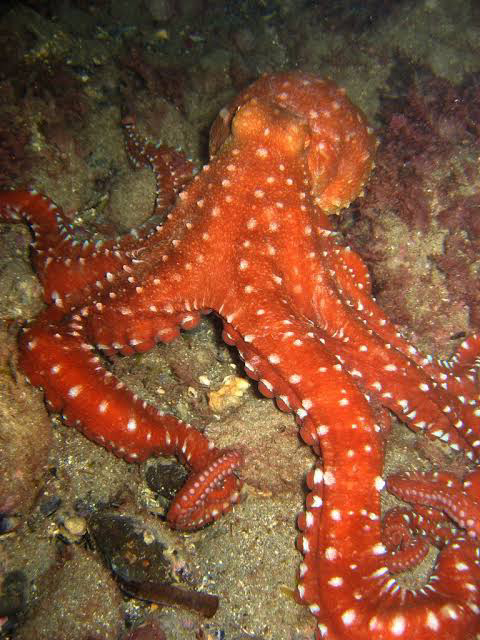THE OCTOPUS
The octopus (plural octopuses) is a soft-bodied, eight-limbed mollusc of the order Octopoda. Around 300 species are recognised, and the order is grouped within the class Cephalopoda with squids, cuttlefish, and nautiloids. Like other cephalopods, the octopus is bilaterally symmetric with two eyes and a beak, with its mouth at the center point of the eight limbs ("tentacle" is used as an umbrella term for cephalopod limbs; however, within a teuthological context, "arm" is used to refer to such limbs while "tentacle" is reserved for feeding appendages not found on octopuses). The soft body can rapidly alter its shape, enabling octopuses to squeeze through small gaps. They trail their eight appendages behind them as they swim. The siphon is used both for respiration and for locomotion, by expelling a jet of water. Octopuses have a complex nervous system and excellent sight, and are among the most intelligent and behaviourally diverse of all invertebrates.
Octopuses inhabit various regions of the ocean, including coral reefs, pelagic waters, and the seabed; some live in the intertidal zone and others at abyssal depths. Most species grow quickly, mature early, and are short-lived. In most species, the male uses a specially adapted arm to deliver a bundle of sperm directly into the female's mantle cavity, after which he becomes senescent and dies, while the female deposits fertilised eggs in a den and cares for them until they hatch, after which she also dies. Strategies to defend themselves against predators include the expulsion of ink, the use of camouflage and threat displays, the ability to jet quickly through the water and hide, and even deceit. All octopuses are venomous, but only the blue-ringed octopuses are known to be deadly to humans.
Octopuses appear in mythology as sea monsters like the Kraken of Norway and the Akkorokamui of the Ainu, and probably the Gorgon of ancient Greece. A battle with an octopus appears in Victor Hugo's book Toilers of the Sea, inspiring other works such as Ian Fleming's Octopussy. Octopuses appear in Japanese erotic art, shunga. They are eaten and considered a delicacy by humans in many parts of the world, especially the Mediterranean and the Asian seas.
Most species are solitary when not mating,though a few are known to occur in high densities and with frequent interactions, signaling, mate defending and eviction of individuals from dens. This is likely the result of abundant food supplies combined with limited den sites.
The larger Pacific striped octopus however is social, living in groups of up to 40 individuals that share dens. Octopuses hide in dens, which are typically crevices in rocky outcrops or other hard structures, though some species burrow into sand or mud. Octopuses are not territorial but generally remain in a home range; they may leave the area in search of food. They can use navigation skills to return to a den without having to retrace their outward route. They are not known to be migratory.
Octopuses bring captured prey back to the den where they can eat it safely. Sometimes the octopus catches more prey than it can eat, and the den is often surrounded by a midden of dead and uneaten food items. Other creatures, such as fish, crabs, molluscs and echinoderms, often share the den with the octopus, either because they have arrived as scavengers, or because they have survived capture.
AMAZING FACTS ABOUT THE OCTOPUS
Changing of colors
Octopuses can control the color of their skin because they have special cells in their skin that are filled with different color( Chromatophores)
To change the color of their skin, octopuses will make the color cells bigger or smaller by stretching or relaxing their muscles. For example, let's focus on cells with red pigment
Squeezing through almost anything
Octopuses have an amazing ability to squeeze through tiny crevices, cracks and holes
But however there's a limit to what the octopus can squeeze through because of their fairly solid mouth




Very informative article. Liked it.
ReplyDeleteInteresting info 🙂
ReplyDeleteAmazing
ReplyDeleteHigh information in short words thanx for sharing
ReplyDeletegoos work
ReplyDeleteNice work
ReplyDeleteMarvelous
ReplyDeletegood info keep it up
ReplyDeleteNyc
ReplyDeleteVery interesting information
ReplyDeleteLovely creatures
ReplyDelete